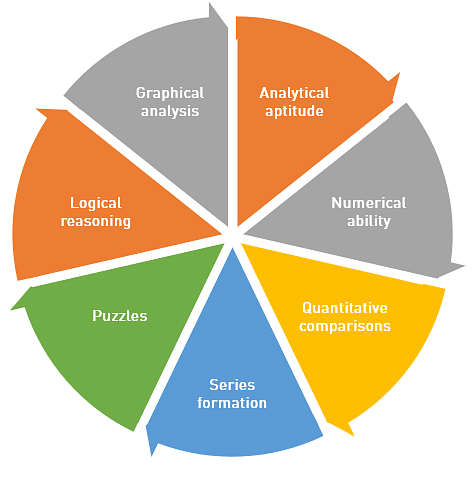CSIR UGC NET Syllabus for Chemical Sciences
CSIR UGC NET is Now from December 2019, Conducted By National Testing Agency(NTA), every year in 2 sessions- June and December. The exam is a portal for candidates seeking admission to the post of Junior Research Fellowship (JRF) and Assistant Professor. The syllabus for the exam is as laid out by Council of Scientific and Industrial Research. CSIR UGC NET syllabus will be of graduation level.
The main topics of CSIR UGC NET Syllabus for Chemical Sciences are-
- Inorganic Chemistry
- Physical Chemistry
- Organic Chemistry
- Spectroscopy
The below article contains all the information related to CSIR UGC NET Syllabus for Chemical Sciences and sample questions for each section.
CSIR UGC NET Chemical Sciences – Part A Syllabus
- Part A will be common to all five streams of studies.
- It will comprise of twenty objective type questions.
- Applicants will have to answer any 15 out of these 20 questions.
- The maximum marks a student can score in this section are 30.
- Each correct answer will be awarded +2 marks while 0.5 marks will be deducted for a wrong answer.
Important topics under this section and some sample questions are given below.
Recommended Books for Chemical Science – Part A
Good reference books and study material are key to success in any top-notch entrance exam. CSIR UGC NET is the premier national level entrance exam for the position of Junior Research Fellowship and Lectureship. Mentioned below are some good books you can rely on –
| Section | Book name | Author/ Publisher |
| General Science | CSIR UG NET- for Part A (Quant Master Series) Paperback | Sudesh Sharma |
| CSIR UGC NET (Science) Paper I Guide | Karan Deo | |
| CSIR UGC NET Compulsory Paper- Part A General Science | Ramesh Publishing House |
Sample Questions
Ques. A sphere of radius 4 cm is carved from a homogeneous sphere of radius 8 cm and mass 160 g. The mass of the smaller sphere is
1. 80 g.
2. 60 g.
3. 40 g.
4. 20 g.
Ques. A person buys a shirt with marked price Rs.300/- at a discount of 20%. In order to make a profit of 20% the person should sell the shirt for
1. Rs.288/-
2. Rs.300/-
3. Rs.240/-
4. Rs.360/-
Ques. In a bag containing only blue, red and green marbles, all but 15 are blue, all but 13 are red and all but 12 are green. How many are red?
1. 13
2. 7
3. 25
4. 20
CSIR UGC NET Chemical Science – Part A Tips
This is a scoring section and so candidates must prepare well for it. A few preparation tips are mentioned below-
- Students must make it a habit to solve at least 20 questions after studying a topic. This habit will help them in understanding the concepts better and they will also be able to solve different types of questions based on this topic.
- Do not refer to many books. Instead, refer to a small number of books and master them.
- Candidates must focus on graph related and numerical based problems as these are asked many times in the exam.
They must devise some easy tricks to solve questions and to save time.
CSIR UGC NET Chemical Sciences – Part B & C Syllabus
These sections will evaluate candidate’s knowledge of scientific concepts for topics given in the syllabus. Aspirants must answer conceptual as also application based questions. The questions will be of analytical nature where a student will be expected to apply scientific concepts to arrive at the solution to the given problem. The highlights of CSIR UGC NET for Part B and Part C are given below
Part B and Part C will comprise MCQs.
- A total of 40 questions will be asked in Part B out of which applicants must attempt 35. Each correct answer will be awarded +2 marks while 0.5 marks will be deducted for a wrong answer.
- The maximum marks of Part B are 70.
- In Part C, individuals must answer any 25 questions out of the given 60 questions. Every correct answer will carry +4 marks while -1 will be deducted for a wrong response.
- The maximum marks for Part C are 100.
- Only the first 35 question (Part B) and 25 questions (Part C) will be evaluated irrespective of the number of questions an individual attempt.
Important topics under both sections and some sample questions are given below:
| Topic | Sub-Topic |
| Inorganic Chemistry | Chemical periodicity Structure and bonding in homo- and heteronuclear molecules Concepts of acids and bases Main group elements and their compounds Transition elements and coordination compounds Inner transition elements Organometallic compounds Cages and metal clusters. Analytical chemistry Bioinorganic chemistry Characterization of inorganic compounds Nuclear chemistry |
| Physical Chemistry | Basic principles of quantum mechanics Approximate methods of quantum mechanics Atomic structure and spectroscopy Chemical bonding in diatomic Chemical applications of group theory Molecular spectroscopy. Chemical thermodynamics Statistical thermodynamics Electrochemistry Chemical kinetics Colloids and surfaces. Solid state Polymer chemistry Data analysis |
| Organic Chemistry | IUPAC nomenclature of organic molecules Principles of stereochemistry Aromaticity Organic reactive intermediates Organic reaction mechanisms Common named reactions and rearrangements Organic transformations and reagents Concepts in organic synthesis Asymmetric synthesis Pericyclic reactions Chemistry involved in natural products Structure determination of organic compounds |
| Interdisciplinary topics | Catalysis and green chemistry. Medicinal chemistry. Chemistry in nanoscience and technology. Environmental chemistry Supramolecular chemistry |
Recommended Books for Chemical Sciences – Part B & C
Some good reference books are discussed below to help individuals study well for these 2 sections.
| Topic | Book name | Author/ Publisher |
| Physical Chemistry | Thermodynamics | Thomas Engel & Philip Reid |
| Quantum Chemistry | Donald A. McQuarrie | |
| Organic Chemistry | Principles of Stereochemistry | P.S Kalsi |
| Organic Reaction Mechanism | Peter Sykes | |
| Pericyclic Reactions | R T Morrison, R N Boyd | |
| Inorganic Chemistry | Chemical Bonding and Shapes of Compounds | J. E Huheey |
| Transition Metals and Co-ordination compounds (d- block) | Bodie Douglas |
Sample Questions for Part B
Ques. The only molecule having bridging oxygen is
1. Phosphorus trioxide
2. Phosphorus pentoxide
3. Cyclic tetra phosphate
4. Pyrophosphate
Ques. The absorbance of solution having 20% transmittance is
1. 0.301
2. 0.699
3. 1.301
4. 1.699
Ques. Using phenolphthalein as the indicator, which of the following titration is possible:
1. acetic acid with pyridine
2. oxalic acid with sodium hydroxide
3. hydrochloric acid with aniline
4. sulphuric acid with aqueous ammonia
Sample Questions for Part C
Ques. 4-tert-Butylcyclohexanoneon reduction gives two isomeric alcohols which are
1. Enantiomers
2. Diastereomers
3. Rotamers
4. Homomers
Ques. Hemocyanin contains
1. A dinuclear copper core and binds dioxygen in the cuprous state.
2. A dinuclear copper core and binds dioxygen in the cupric state.
3. A mononuclear copper core and binds dioxygen in the cuprous state
4. A mononuclear copper core and binds dioxygen in the cupric state.
Ques. Unlike d-d transitions, the f-f transitions
1. Does not change much with change in ligand
2. Change significantly with change in ligand
3. Appear at low energies i.e. at the near-IR region
4. Appear as broad bands
CSIR UGC NET Chemical Science – Part B & C Tips
These sections have the maximum weightage and so students must prepare well for it. A few preparation tips are mentioned below-
- Study all the topics thoroughly. Do not leave out any topic as questions from each topic are equally likely to be asked in the exam.
- Candidates must study and revise mechanisms of reactions and various reagents regularly. These mechanisms can be used to carry out reactions even if applicants do not know the reactions.
- They must solve previous years’ question papers and mock tests regularly. This will help them to understand the pattern of the exam better as also the kind of questions asked.
- Aspirants should only attempt those questions which they are confident about as negative marking will be applicable.
CSIR UGC NET Exam Old Pattern
CSIR UGC NET is conducted for the Science stream in the fields of Chemical Sciences, Life Sciences, Earth Sciences, Mathematical and Physical Sciences. The question paper will be divided into 3 sections all of which are compulsory. Part A will be common for all the streams while questions in Part B and C will be asked from the particular field. The details regarding the exam pattern are mentioned below-
| Mode of CSIR UGC NET | Offline |
| Number of sections | 3 |
| Marks for Correct Answer | Part A and B: +2 Part C: +4 |
| Negative Marking | Part A and B: -0.5 Part C: -1 |
| Duration of exam | 3 hours |



Valuable stuff! Thanks for sharing this.
http://www.guruchandigarh. com